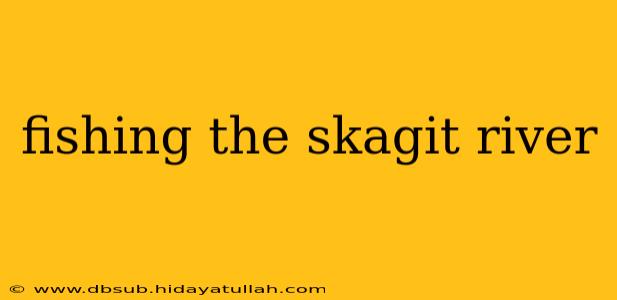The Skagit River, a majestic waterway carving its path through the North Cascades of Washington State, is a fly fishing mecca renowned for its abundant salmon and steelhead runs. For anglers seeking a challenging and rewarding experience, the Skagit offers unparalleled opportunities, but understanding its nuances is key to success. This comprehensive guide will explore the river's diverse fishing opportunities, techniques, and best practices for a memorable trip.
Understanding the Skagit River's Ecosystem
The Skagit's diverse ecosystem is what makes it so special. Fed by glacial meltwater and rainfall, its waters are pristine and cold, supporting a thriving population of salmon (Chinook, Coho, Sockeye, Pink) and steelhead. The river’s varied terrain, from swift currents to slower pools and riffles, creates a variety of habitats that attract different species at different times of the year. Understanding these variations is crucial for targeting specific fish.
Key Tributaries and Their Significance
Several significant tributaries feed into the Skagit, each offering unique fishing experiences:
- The Sauk River: Known for its strong steelhead runs, particularly in the fall.
- The Suiattle River: A challenging but rewarding fishery known for large Chinook salmon.
- The Cascade River: Offers excellent opportunities for both steelhead and trout fishing.
Understanding the specific characteristics of each tributary will enhance your chances of success.
Seasonal Fishing Opportunities on the Skagit
The Skagit River's fishing season is dynamic, with different species migrating at different times of the year.
Spring Fishing (March - May)
Spring brings the arrival of early steelhead, often bright and aggressive. Nymphing and swinging flies are effective techniques during this period. The river can be high and fast, requiring anglers to adapt their techniques.
Summer Fishing (June - August)
Summer fishing focuses primarily on resident trout, including rainbow and cutthroat. Dry fly fishing becomes more prevalent, with the use of smaller patterns. The river levels typically stabilize during this period.
Fall Fishing (September - November)
Fall is arguably the peak season on the Skagit, with significant runs of Chinook and Coho salmon, alongside late-season steelhead. This is a time of high excitement and often requires skillful wading and drift boat techniques.
Winter Fishing (December - February)
Winter fishing on the Skagit is possible, but challenging due to cold temperatures and potential high water levels. Experienced anglers targeting winter steelhead often employ techniques like bobber fishing or indicator nymphing.
Essential Fly Fishing Techniques for the Skagit
The Skagit River demands a versatile approach to fly fishing. Successful anglers adapt to the river's changing conditions.
Swinging Flies
Swinging flies is a highly effective technique for steelhead and salmon, especially in faster currents. This involves allowing your fly to drift naturally downstream, mimicking the movement of a natural prey.
Nymphing
Nymphing involves presenting weighted flies beneath the surface, imitating nymphs and other aquatic insects. This is a particularly effective technique during lower water flows.
Dry Fly Fishing
Dry fly fishing is a popular method during summer months when insects are more active. This involves presenting dry flies on the surface, imitating hatching insects.
Essential Gear and Equipment
Proper gear is crucial for a successful fishing trip. Key items include:
- Waders and boots: High-quality waders are essential for staying dry and warm in the often cold water.
- Rods: A variety of rods will be needed depending on the species being targeted, from 8-weight for steelhead to 6-weight for trout.
- Reels: A strong, reliable reel capable of handling heavier line is crucial.
- Lines: Appropriate lines are essential for the chosen technique, including floating, sinking, and specialized lines for specific conditions.
- Flies: A selection of flies designed to imitate the river's natural prey is crucial.
Respecting the Skagit River Environment
Responsible angling practices are paramount for preserving the Skagit River's pristine environment and ensuring sustainable fishing for future generations. Always follow catch-and-release practices where applicable, practice Leave No Trace principles, and respect all regulations.
The Skagit River is a truly remarkable place to experience the thrill of fly fishing. By understanding its ecosystem, seasonal changes, and essential techniques, you can significantly enhance your fishing experience and create lasting memories. Remember to always check current fishing regulations and obtain necessary licenses before embarking on your adventure.
